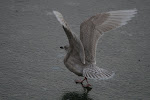This morning's CES at Vallen was very slow indeed catching less than 20 birds (retrap Thrush Nightingale, Blackbird, Reed Warbler, Sedge Warbler, Willow Warbler, Blackcap, Chaffinch, Reed Bunting, Great Tit and Marsh Tit) and there wasn't really even a highlight, so I didn't get my camera out once. I was starting to think that I wouldn't have enough 'excitement' to make a valuable blog post. I decided to put up some nets in the garden and managed to catch these two lovely birds.
The nominate race of Nuthatch is a stunning bird, and this adult male must be the pick of the bunch! In England (as many of the ringers reading this will know) it is said that Nuthatch cannot be aged accurately after their post juvenile moult as they look identical to adults. In Sweden however, this is not the case. The inset on the picture below shows the eye colour of this 3rd calender bird as being very rich chestnut. Juvenile birds have a very olive/grey eye, 2CYs have a dark browny-grey eye and then full adults have rich chestnut eyes. The photo below also shows the rich chestnut flanks that identify this as a male, and the fantastic undertail coverts of this species.
The juvenile Treecreeper was ringed yesterday in the garden and we retrapped it again today. This is surprisingly the first Treecreeper to be caught this year at the Obs.
Hopefully tomorrow will bring a more exciting blogpost!
Sunday, 22 July 2012
Subscribe to:
Post Comments (Atom)




2 comments:
Great blog Zac. Will follow you from now on!
/Magnus Friberg
Nuthatches (in the UK) are actually quite easy to age using plumage; 1/2cy birds show a moult limit in the median coverts, usually 2–3 retained juvenile coverts. There is also a difference in the colour of the greater coverts (greyish-tinged juvenile coverts in 1/2cy contrasted with the [moulted] blue body plumage; bluer greater coverts in adults show little/no contract with the blue body plumage). Additionally, British birds will also show the differences in iris colour — just because it's only the Swedes that use it doesn't mean it's only the Swedish birds that show it ;)
Post a Comment